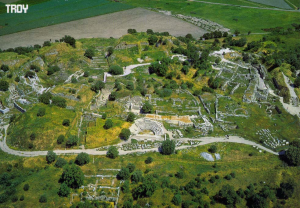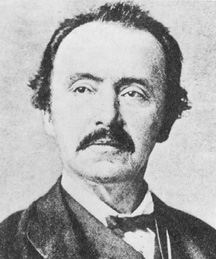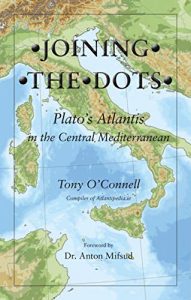Charles Maclaren
Troy
Troy is believed to have been founded by Ilus, son of Troas, giving it the names of both Troy and Ilios (Ilium) with some minor variants.
“According to new evidence obtained from excavations, archaeologists say that the ancient city of Troy in northwestern Turkey may have been more than six centuries older than previously thought. Rüstem Aslan, who is from the Archaeology Department of Çanakkale Onsekiz Mart University (ÇOMU), said that because of fires, earthquakes, and wars, the ancient city of Troy had been destroyed and re-established numerous times throughout the years.” This report pushes the origins of this famous city back to around 3500 BC(s).
Dating Homer’s Troy has produced many problems. Immanuel Velikovsky has drawn attention to some of these difficulties(aa). Ralph S. Pacini endorsed Velikovsky’s conclusion that the matter could only be resolved through a revised chronology. Pacini noted that “the proposed correction of Egyptian chronology produces a veritable flood of synchronisms in the ancient middle east, affirming many of the statements by ancient authors which had been discarded by historians as anachronisms.”(z)
The precise date of the ending of the Trojan War continues to generate comment. A 2012 paper by Rodger C. Young and Andrew E. Steinmann has offered evidence that the conclusion of the conflict occurred in 1208 BC, which agrees with the date recorded on the Parian Marble(ah). This obviously conflicts with the date calculated by Eratosthenes of 1183 BC. A 2009 paper(ai) by Nikos Kokkinos delves into the methodology used by Eratosthenes to arrive at this date. Peter James has listed classical sources that offered competing dates ranging from 1346 BC-1127 BC, although Eratosthenes’ date had more general acceptance by later commentators [46.327] and still has support today.
New dating for the end of the Trojan War has been presented by Stavros Papamarinopoulos et al in a paper(aj) now available on the Academia.edu website. Working with astronomical data relating to eclipses in the 2nd millennium BC, they have calculated the ending of the War to have taken place in 1218 BC and Odysseus’ return in 1207 BC.
The city is generally accepted by modern scholars to have been situated at Hissarlik in what is now northwest Turkey. Confusion over identifying the site as Troy can be traced back to the 1st century AD geographer Strabo, who claimed that Ilion and Troy were two different cities!(t) In the 18th century, many scholars consider the village of Pinarbasi, 10 km south of Hissarlik, as a more likely location for Troy.
The Hisarlik “theory had first been put forward in 1821 by Charles Maclaren, a Scottish newspaper publisher and amateur geologist. Maclaren identified Hisarlik as the Homeric Troy without having visited the region. His theory was based to an extent on observations by the Cambridge professor of mineralogy Edward Daniel Clarke and his assistant John Martin Cripps. In 1801, those gentlemen were the first to have linked the archaeological site at Hisarlik with historic Troy.”(m)
The earliest excavations at Hissarlik began in 1856 by a British naval officer, John Burton. His work was continued in 1863 until 1865 by an amateur researcher, Frank Calvert. It was Calvert who directed Schliemann to Hissarlik and the rest is history(j).
However, some high-profile authorities, such as Sir Moses Finley (1912-1986), have denounced the whole idea of a Trojan War as fiction in his book, The World of Odysseus [1139]. Predating Finley, in 1909, Albert Gruhn argued against Hissarlik as Troy’s location(i).
Not only do details such as the location of Troy or the date of the Trojan War continue to be matters for debate, but surprisingly, whether the immediate cause of the Trojan War, Helen of Troy was ever in Troy or not, is another source of controversy. A paper(ab) by Guy Smoot discusses some of the difficulties. “Odysseus’, Nestor’s and Menelaos’ failures to mention that they saw or found Helen at Troy, combined with the fact that the only two witnesses of her presence are highly untrustworthy and problematic, warrant the conclusion that the Homeric Odyssey casts serious doubts on the version attested in the Homeric Iliad whereby the daughter of Zeus was detained in Troy.”
The Swedish scholar, Martin P. Nilsson (1874-1967) who argued for a Scandinavian origin for the Mycenaeans [1140], also considered the identification of Hissarlik with Homer’s Troy as unproven.
A less dramatic relocation of Troy has been proposed by John Chaple who placed it inland from Hissarlik. This “theory suggests that Hisarlik was part of the first defences of a Trojan homeland that stretched far further inland than is fully appreciated now and probably included the entire valley of the Scamander and its plains (with their distinctive ‘Celtic’ field patterns). That doesn’t mean to say that most of the battles did not take place on the Plain of Troy near Hisarlik as tradition has it but this was only the Trojans ‘front garden’ as it were, yet the main Trojan territory was behind the defensive line of hills and was vastly bigger with the modern town of Ezine its capital – the real Troy.” (af)
Troy as Atlantis is not a commonly held idea, although Strabo, suggested such a link. So it was quite understandable that when Swiss geo-archaeologist, Eberhard Zangger, expressed this view [483] it caused quite a stir. In essence, Zangger proposed(g) that Plato’s story of Atlantis  was a retelling of the Trojan War.
was a retelling of the Trojan War.
For me, the Trojan Atlantis theory makes little sense as Troy was to the northeast of Athens and Plato clearly states that the Atlantean invasion came from the west. In fact, what Plato said was that the invasion came from the ‘Atlantic Sea’ (pelagos). Although there is some disagreement about the location of this Atlantic Sea, all candidates proposed so far are west of both Athens and Egypt.(Tim.24e & Crit. 114c)
Troy would have been well known to Plato, so why did he not simply name them? Furthermore, Plato tells us that the Atlanteans had control of the Mediterranean as far as Libya and Tyrrhenia, which is not a claim that can be made for the Trojans. What about the elephants, the two crops a year or in this scenario, where were the Pillars of Heracles?
A very unusual theory explaining the fall of Troy as a consequence of a plasma discharge is offered by Peter Mungo Jupp on The Thunderbolts Project website(d) together with a video(e).
Zangger proceeded to re-interpret Plato’s text to accommodate a location in North-West Turkey. He contends that the original Atlantis story contains many words that have been critically mistranslated. The Bronze Age Atlantis of Plato matches the Bronze Age Troy. He points out that Plato’s reference to Atlantis as an island is misleading, since, at that time in Egypt where the story originated, they frequently referred to any foreign land as an island. He also compares the position of the bull in the culture of Ancient Anatolia with that of Plato’s Atlantis. He also identifies the plain mentioned in the Atlantis narrative, which is more distant from the sea now, due to silting. Zangger considers these Atlantean/Trojans to have been one of the Sea Peoples who he believes were the Greek-speaking city-states of the Aegean.
Rather strangely, Zangger admits (p.220) that “Troy does not match the description of Atlantis in terms of date, location, size and island character…..”, so the reader can be forgiven for wondering why he wrote his book in the first place. Elsewhere(f), another interesting comment from Zangger was that “One thing is clear, however: the site of Hisarlik has more similarities with Atlantis than with Troy.”
There was considerable academic opposition to Zangger’s theory(a). Arn Strohmeyer wrote a refutation of the idea of a Trojan Atlantis in a German-language book [559].
An American researcher, J. D. Brady, in a somewhat complicated theory, places Atlantis in the Bay of Troy.
In January 2022, Oliver D. Smith who is unhappy with Hisarlik as the location of Troy and dissatisfied with alternatives offered by others, proposed a Bronze Age site, Yenibademli Höyük, on the Aegean island of Imbros(v). His paper was published in the Athens Journal of History (AJH).
To confuse matters further Prof. Arysio Nunes dos Santos, a leading proponent of Atlantis in the South China Sea places Troy in that same region of Asia(b).
Furthermore, the late Philip Coppens reviewed(h) the question marks that still hang over our traditional view of Troy.
Felice Vinci has placed Troy in the Baltic and his views have been endorsed by the American researcher Stuart L. Harris in a number of articles on the excellent Migration and Diffusion website(c). Harris specifically identifies Finland as the location of Troy, which he claims fell in 1283 BC although he subsequently revised this to 1190 BC, which is more in line with conventional thinking. The dating of the Trojan War has spawned its own collection of controversies.
However, the idea of a northern source for Homeric material is not new. In 1918, an English translation of a paper by Carus Sterne (Dr Ernst Ludwig Krause)(1839-1903) was published under the title of The Northern Origin of the Story of Troy(n). Iman Wilkens is arguably the best-known proponent of a North Atlantic Troy, which he places in Britain. Another scholar, who argues strongly for Homer’s geography being identifiable in the Atlantic, is Gerard Janssen of the University of Leiden, who has published a number of papers on the subject(u). Robert John Langdon has endorsed the idea of a northern European location for Troy citing Wilkens and Felice Vinci (w). However, John Esse Larsen is convinced that Homer’s Troy had been situated where the town Bergen on the German island of Rügen(x) is today.
Most recently (May 2019) historian Bernard Jones(q) has joined the ranks of those advocating a Northern European location for Troy in his book, The Discovery of Troy and Its Lost History [1638]. He has also written an article supporting his ideas in the Ancient Origins website(o). For some balance, I suggest that you also read Jason Colavito’s comments(p).
Steven Sora in an article(k) in Atlantis Rising Magazine suggested a site near Lisbon called ‘Troia’ as just possibly the original Troy, as part of his theory that Homer’s epics were based on events that took place in the Atlantic. Two years later, in the same publication, Sora investigated the claim for an Italian Odyssey(l). In the Introduction to The Triumph of the Sea Gods [395], he offers a number of incompatibilities in Homer’s account of the Trojan War with a Mediterranean backdrop.
Roberto Salinas Price (1938-2012) was a Mexican Homeric scholar who caused quite a stir in 1985 in Yugoslavia, as it was then when he claimed that the village of Gabela 15 miles from the Adriatic’s Dalmatian coast in what is now Bosnia-Herzegovina, was the ‘real’ location of Troy in his Homeric Whispers [1544].
More recently another Adriatic location theory has come from the Croatian historian, Vedran Sinožic in his book Naša Troja (Our Troy) [1543]. “After many years of research and exhaustive work on collecting all available information and knowledge, Sinožic provides numerous arguments that prove that the legendary Homer Troy is not located in Hisarlik in Turkey, but is located in the Republic of Croatia – today’s town of Motovun in Istria.” Sinožic who has been developing his theory over the past 30 years has also identified a connection between his Troy and the Celtic world.
Similarly, Zlatko Mandzuka has placed the travels of Odysseus in the Adriatic in his 2014 book, Demystifying the Odyssey[1396].
Fernando Fernández Díaz is a Spanish writer, who has moved Troy to Iberia in his Cómo encontramos la verdadera Troya (y su Cultura material) en Iberia [1810] (How we find the real Troy (and its material Culture) in Iberia.).
Like most high-profile ancient sites, Troy has developed its own mystique, inviting the more imaginative among us to speculate on its associations, including a possible link with Atlantis. Recently, a British genealogist, Anthony Adolph, has proposed that the ancestry of the British can be traced back to Troy in his book Brutus of Troy[1505]. Petros Koutoupis has written a short review of Adolph’s book(ad).
Caleb Howells, a content writer for the Greek Reporter website, among others, has written The Trojan Kings of Britain [2076] due for release in 2024. In it he contends that the legend of Brutus is based on historical facts. However, Adolph came to the conclusion that the story of Brutus is just a myth(ae), whereas Howells supports the opposite viewpoint.
Iman Wilkens delivered a lecture(y) in 1992 titled ‘The Trojan Kings of England’.
It is thought that Schliemann has some doubts about the size of the Troy that he unearthed, as it seemed to fall short of the powerful and prestigious city described by Homer. His misgivings were justified when many decades later the German archaeologist, Manfred Korfmann (1942-2005), resumed excavations at Hissarlik and eventually exposed a Troy that was perhaps ten times greater in extent than Schliemann’s Troy(r).
An anonymous website with the title of The Real City of Troy(ag) began in 2020 and offers regular blogs on the subject of Troy, the most recent (as of Dec. 2023) was published in Nov. 2023. The author is concerned with what appear to be other cities on the Plain of Troy unusually close to Hissarlik!
(a) https://web.archive.org/web/20150912081113/https://bmcr.brynmawr.edu/1995/95.02.18.html
(b) http://www.atlan.org/articles/atlantis/
(c) http://www.migration-diffusion.info/article.php?authorid=113
(d) https://www.thunderbolts.info/wp/2013/09/16/troy-homers-plasma-holocaust/
(e) Troy – Homers Plasma holocaust – Episode 1 – the iliad (Destructions 17) (archive.org) *
(f) https://www.moneymuseum.com/pdf/yesterday/03_Antiquity/Atlantis%20en.pdf
(g) https://www.youtube.com/watch?v=mo-lb2AAGfY
(h) https://www.philipcoppens.com/troy.html or See: Archive 2482
(i) https://www.jstor.org/stable/496830?seq=14#page_scan_tab_contents
(j) https://turkisharchaeonews.net/site/troy
(k) Atlantis Rising Magazine #64 July/Aug 2007 See: Archive 3275
(l) Atlantis Rising Magazine #74 March/April 2009 See: Archive 3276
(m) https://luwianstudies.org/the-investigation-of-troy/
(n) The Open Court magazine. Vol.XXXII (No.8) August 1918. No. 747 See: https://archive.org/stream/opencourt_aug1918caru/opencourt_aug1918caru_djvu.txt
(o) https://www.ancient-origins.net/ancient-places-europe/location-troy-0011933
(q) https://www.trojanhistory.com/
(r) Manfred Korfmann, 63, Is Dead; Expanded Excavation at Troy – The New York Times (archive.org)
(t) https://web.archive.org/web/20121130173504/http://www.6millionandcounting.com/articles/article5.php
(u) https://leidenuniv.academia.edu/GerardJanssen
(x) http://odisse.me.uk/troy-the-town-bergen-on-the-island-rugen-2.html
(y) https://phdamste.tripod.com/trojan.html
(z) http://www.mikamar.biz/rainbow11/mikamar/articles/troy.htm (Link broken)
(aa) Troy (varchive.org)
(ab) https://chs.harvard.edu/guy-smoot-did-the-helen-of-the-homeric-odyssey-ever-go-to-troy/
(ac) https://www.ancient-origins.net/myths-legends-europe/aeneas-troy-0019186
(ad) https://diggingupthepast.substack.com/p/rediscovering-brutus-of-troy-the#details
(ae) https://anthonyadolph.co.uk/brutus-of-troy/
(af) http://www.johnchaple.co.uk/troy.html
(aj) http://www.academia.edu/7806255/A_NEW_ASTRONOMICAL_DATING_OF_THE_TROJAN_WARS_END *
Schliemann, Heinrich
Heinrich Schliemann (1822-1890) and Sir Arthur Evans famed as the discoverers of Troy and Knossos respectively are sometimes  claimed to have believed in the existence of Atlantis. John Michell quotes [0704.200] the following from Schliemann; “I have come to the conclusion that Atlantis was not only a great territory between America and the west coast of Africa, but the cradle of all our civilisation as well.” This extract is from a letter that was allegedly given to his grandson, Paul Schliemann. However, the letter in question was just part of a larger hoax perpetrated in 1912.
claimed to have believed in the existence of Atlantis. John Michell quotes [0704.200] the following from Schliemann; “I have come to the conclusion that Atlantis was not only a great territory between America and the west coast of Africa, but the cradle of all our civilisation as well.” This extract is from a letter that was allegedly given to his grandson, Paul Schliemann. However, the letter in question was just part of a larger hoax perpetrated in 1912.
Although Schliemann is credited with the discovery of Troy at Hissarlik in Turkey, he was not the first to suggest the site, in fact nearly a century earlier, ironically, in the year that Schliemann was born, Charles Maclaren (1782-1866), a Scot, also claimed that Hissarlik was the location of Troy in a work entitled, A Dissertation on the Topography of the Plain of Troy[541]. Others have cast doubt on the specific site identified by Schliemann.
L. Taylor Hansen noted that when Heinrich Schliemann declared that he was selling his business and going in search of Troy “archaeologists and others in the colleges burst into laughter.” However, when it was announced that he had found Troy, she tells us that “one of the scientists who had laughed the loudest and longest was so mortified that he committed suicide.” [572.22]
A somewhat harsh assessment of Schliemann’s site work noted that “he recklessly dug deeper and deeper—right through the ruins that were most likely the Troy he was looking for until he found a city that predated the Trojan war by at least 1,000 years. There’s even a big gap in the excavation map where King Priam’s palace was found. Schliemann removed it and threw it away. So we can all thank Schliemann for everything we do and don’t know about these ruins. He discovered the site, then demolished a lot of the important bits with his hamfisted approach.”(b)
The principal objection to Schliemann’s Troy was that the city he had located was too small to match the historical descriptions of Troy. The same might be said of many of the sites proposed as Plato’s Atlantis.
Schliemann also discovered many hundreds of swastikas throughout the Hissarlik site and is credited with bringing that symbol back to Germany, where it was later hijacked by the Nazis and came to represent evil oppression.(a)
Robert Temple notes in The Crystal Sun [928.39] that Schliemann excavated 49 convex crystal lenses that Temple has identified as optical artifacts. Despite earlier denials, these lenses along with the Trojan Gold, also known as Priam’s Treasure, discovered by Schliemann were plundered by the Russians after World War II and are still in their possession(c).
